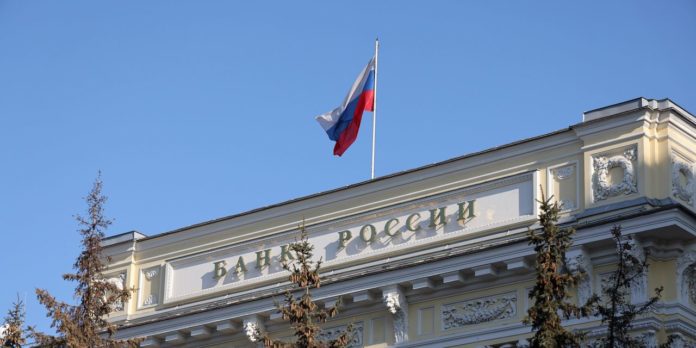Russia’s finance minister said the country paid what it owed on its foreign debts on Wednesday but wasn’t sure if the payments would go through, blaming U.S. sanctions for setting the country on the path toward default.
The Russian government is required to pay $117 million in interest payments on two dollar-denominated government bonds Wednesday. Failure to pay, or attempting to pay in rubles instead of dollars as required by the bonds, would set the stage for Russia to be placed in default by its creditors.
The bonds have a 30-day grace period, meaning creditors can’t declare an official default until April 15.
“The possibility or impossibility of fulfilling our obligations in foreign currency does not depend on us,” Finance Minister
Anton Siluanov
said in an interview with state-owned Russia Today. “We have the money, we paid the payment, now the ball is on the side, first of all, of the American authorities.” Earlier this week, he indicated that the payment might end up being made in rubles.
Mr. Siluanov added that Russia sent the required dollars to the U.S. bank where Moscow holds its foreign-currency account. While the payment is being processed, there has been no confirmation of whether it has gone through, he said.
Russia’s U.S. bank has been in contact with the U.S.’s Office of Foreign Assets Control, which enforces U.S. sanctions, according to the finance minister. If restrictions prevent money from reaching U.S. and European investors, Mr. Siluanov said Russia has created an alternative procedure to pay bondholders in rubles.
An investor who holds both of the bonds said that he hadn’t received payment as of 5:45 p.m. Eastern time
The last time Russia reneged on its foreign debts was after the Bolshevik Revolution in 1918. Russia defaulted on its local-government debt in 1998 as the post-Soviet economy struggled to find its feet. Oil prices had collapsed to $10 a barrel, starving the government of revenue. The crisis set the stage for President
eventual rise to power at the end of 1999.
In theory, Russia has plenty of money. Heading into the war with Ukraine it had accumulated more than $630 billion in foreign-currency reserves, which in normal times it can use to pay its debts.
But punishing U.S. sanctions on Russia’s central bank and finance ministry have thrown into question what Russia is permitted to do with the reserves.
The U.S. barred transactions by American institutions with Russia’s central bank and finance ministry but later issued a temporary exemption that allows U.S. and foreign banks to receive payment for Russia’s debt obligations in the currencies determined by the bond contracts.
Payment of interest on bonds issued before March 1 by Russia’s central bank, national wealth fund or finance ministry are permissible through May 25, the Treasury Department said.
“Simply put, U.S. sanctions on Russia do not prohibit Russia from making these debt payments,” a U.S. Treasury Department spokeswoman said Wednesday.
After that exemption expires, a specific license approved by the Treasury would be required to continue to receive interest, dividend or maturity payments on debt or equity issued by Russia’s government institutions, it said.
Investors and analysts expect that under those rules, Russia would still be able to service its foreign-currency debt in the coming weeks.
“They’re playing a game of chicken with the West,” said
Timothy Ash,
senior emerging-market sovereign strategist at BlueBay Asset Management. “Our understanding is that it is possible to make the payment.”
Russia’s possible default has rekindled memories of the country’s 1998 debt crisis, which reverberated around the world and unleashed a big swoon on Wall Street. It led to the unraveling of hedge fund Long-Term Capital Management and required a Federal Reserve-organized bailout by major Wall Street banks.
While Russia’s invasion of Ukraine has had a significant impact on markets, an official determination of debt default isn’t necessarily going to be a trigger for further market turbulence.

Russia’s possible default has rekindled memories of the country’s 1998 debt crisis. Russian President Vladimir Putin chaired a teleconference meeting with members of the government in Moscow on March 10.
Photo:
mikhail klimentyev/Agence France-Presse/Getty Images
Foreign investors who run emerging-markets portfolios held Russian debt before the war, but Russia was just a slice of the global universe of bonds. Many investors have already written down the value of the bonds to a level indicating that Russia will be in a long financial freeze.
Ratings company Fitch said a payment in rubles to holders of Russia’s dollar-denominated bonds would constitute a default, once the 30-day grace period expires. A default on local-government debt could come even sooner. Fitch said that if the Russian state doesn’t pay holders of its local-currency bonds in the 30 days after it didn’t forward payments to foreign bondholders on March 2, it would also declare the country in default.
Mr. Putin put the blame on Europe and the U.S. in comments Wednesday. He said the U.S. and European Union “announced the most real default of their own obligations before Russia” when they placed sanctions on Russia’s foreign-currency reserves.
He said countries would “convert their paper and digital reserves into real reserves in the form of raw materials, land, food supplies, gold and other real assets, which will only accelerate the shortages in these markets.”
The Biden administration has portrayed Moscow’s treatment of how and whether to pay its bonds as a choice between honoring its contractual obligations and funding its war in Ukraine.
“The Russian economy is in a state of pain. It’s in a financial crisis,”
Wally Adeyemo,
deputy secretary of the U.S. Treasury, said on CNBC on Monday. “They’re going to have to make choices about what debts they pay going forward, and those choices will ultimately put [Mr. Putin] in a position where he has to make a decision about whether he continues the invasion or stops that invasion.”
Moscow has a further $615 million in payments due by the end of March to bondholders, some of which can be paid in rubles. Russia faces an even bigger hurdle in April, when it has a $2 billion bond maturing, which will require dollars to be paid out.
“It’s just a lot of wait-and-see at the moment for so much of it. Everyone is spending a lot of time trying to get their heads around all these questions,” said
Daniel Wood,
a portfolio manager at William Blair Investment Management.
The bonds maturing in 2023 traded at around 27 cents on the dollar with a 124% yield on Tuesday, compared with less than 2% at the beginning of the year, according to AdvantageData. Those maturing in 2043 were bought and sold for around 22 cents in the same time frame.
—Anna Hirtenstein and Alexander Osipovich contributed to this article.
Write to Caitlin Ostroff at caitlin.ostroff@wsj.com, Alexander Saeedy at alexander.saeedy@wsj.com and Ian Talley at Ian.Talley@wsj.com
Copyright ©2022 Dow Jones & Company, Inc. All Rights Reserved. 87990cbe856818d5eddac44c7b1cdeb8
Source link






